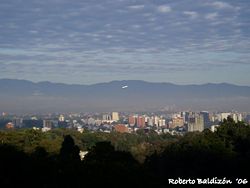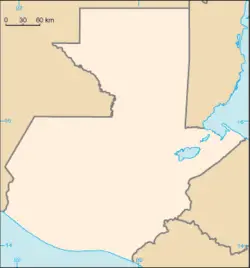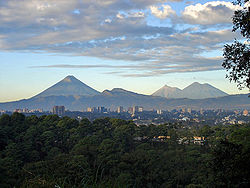Guatemala City
| Guatemala City La Nueva Guatemala de la Asunción |
|
| Guatemala City | |
| Nickname: Guate | |
| Motto: "Tu eres la ciudad" (You are the city) | |
| Location within Guatemala | |
| Coordinates: {{#invoke:Coordinates|coord}}{{#coordinates:14|37|22.48|N|90|31|53.33|W|type:city | |
|---|---|
| name= }} | |
| Country | |
| Department | Guatemala |
| Municipality | Guatemala |
| Established | 1773 |
| Government | |
| - Mayor | Álvaro Arzú |
| Area | |
| - Total | 692 km² (267.2 sq mi) |
| - Land | 1,905 km² (735.5 sq mi) |
| Elevation | 1,500 m (4,921 ft) |
| Population (2008) | |
| - Total | 7,156,000 |
| Time zone | GMT-6 (UTC-6) |
| Website: Municipalidad de Guatemala | |
Guatemala City (in full, La Nueva Guatemala de la Asunción; locally known as Guatemala or Guate) is the capital and largest city of the nation of Guatemala. It is also the capital city of the local Guatemala Department and the largest city in Central America.
As of the 2006 census, the city had a population of 1,202,536 although it has grown in great amounts through the last two years. [1] The city is located at , in a mountain valley in the south central part of the country.
Population
The current population estimates for Guatemala City are about 7,156,000 in the greater metropolitan region.[2] Guatemalans have a diversity of origins, with Spanish and Mestizo descent being the most common. There are also important Indigenous communities and smaller German, Jewish and Korean.
Guatemala City's population continues to increase with the influx of predominantly indigenous migrants from the other departments as well as people from other countries coming to live to the city.
History
Within the confines of modern Guatemala City is the ancient Maya city of Kaminaljuyu. Kaminaljuyu dates back some 9,000 years and is one of the Americas' most notable archaeological sites. The center of Kaminaljuyu was located a short distance from the oldest part of Guatemala City. However, in the late 20th century, the city grew around the ruins, and, in some cases, over some of the outlying ruins before they were protected. Many of the several hundred temple mounds have been built over with freeways, shopping centers, commerce, luxury hotels and residential areas. The central ceremonial center of Kaminaljuyu was protected by the Guatemalan government and is now a park within the city. Even so, there are some ruins still alive that are protected by the government.
In Spanish colonial times, Guatemala City was a small town. It had a monastery called 'El Carmen', founded in 1629. The capital of Spanish colonial Central America was moved here after a water volcano destroyed the old capital, Antigua Guatemala, in 1775. King Charles III of Spain authorized the moving of the capital on September 27, 1775. This resulted in a great expansion of the city.
The city was the scene of the declaration of independence of Central America from Spain, and became the capital of the United Provinces of Central America in 1821.
Today
Guatemala City is the economic, governmental and cultural capital of the Republic, and it functions as the main port of entry into the country, with the country's largest international airport, La Aurora International Airport. In addition to a wide variety of restaurants, hotels and shops, the city has a wide variety of art galleries and museums (including some fine collections of Pre-Columbian art) and continually offers an increasing amount of cultural activities.
Structure and growth
Guatemala City is subdivided into 25 zones (although zones 20, 22, and 23 don't exist), each one with its own streets and avenues, making it very easy to find addresses in the city. However, the city has grown so fast in the past years that it has already absorbed most of the neighboring towns, including Villa Nueva, Santa Catarina Pinula, Mixco, and the suburban area of Carretera a El Salvador, currently a big commercial and residential part of the city.
Zone One is the amazing Historic Center, (Centro Histórico), lying in the very heart of the city, the location of many important buildings including the Palacio Nacional (National Palace), the Metropolitan Cathedral, the National Congress, the Casa Presidencial (Presidential House), the National Library and Central Park.
Places of interest by zones
Zone 1
- Railway Museum [1]
- Centro Histórico [2]
- National Palace (Guatemala) and Metropolitan Cathedral
- Mercado Central (central market)
- Biblioteca Nacional (national library)
Zone 2
- Mapa en Relieve (giant map of Guatemala) and surrounding parks [3]
Zone 4
- Centro Cultural Miguel Ángel Asturias
- Cuatro Grados Norte trendy pedestrian area
- Visa Immigration Office for all foreigners
Zone 7
- Kaminaljuyu and Museo Miraflores [4]
Zone 9
- Torre del Reformador tower
- Parque de la Industria, fairgrounds [5]
- Avenida Reforma and El Obelisco, a parklike boulevard
Zone 10
- Museo Ixchel del Traje Indígena (Mayan dress museum) [6]
- Museo Popol Vuh [7]
- Zona Viva entertainment district
- Botanical garden [8]
Zone 11
- Mcdonald's Utatlán which is one of the largest worldwide
Zone 13
- Museo de Arqueología y Etnología (archaeological museum) [9]
- La Aurora Zoo [10]
- La Aurora International Airport
Transportation
- The newly renovated and expanded La Aurora International Airport lies in the southern part of the city and is the main gateway to the country.
- Urban public transportation is provided solely by bus. Guatemala City does not have an efficient public transportation service, despite the many proposals and projects for the construction of a mass transit system. Although the construction of freeways and underpasses by the municipal government, as well as the establishment of the Department of Metropolitan Transit Police, PMT, has helped traffic flow in the city, the Guatemalan metropolitan area faces a growing transportation problem. However, a new project called Transmetro, consisting of special-purpose lanes for high-capacity buses, began operating in 2007 and aims to improve traffic flow in the city.[11]
Universities
There are 10 universities, Universidad Mariano Gálvez, Universidad Panamericana, Universidad Mesoamericana, Universidad Rafael Landivar, Universidad Francisco Marroquin, Universidad del Valle, Universidad del Istmo, Universidad Galileo, Universidad Rural and Universidad de San Carlos, the only public one and third oldest university in America.
Sports
Guatemala City possesses several sportsgrounds and is home to many sports clubs. Football is the most popular sport, with Comunicaciones, CSD Municipal, and Aurora FC being the main clubs. The Estadio Mateo Flores, located in the Zone 5 of the city, is the largest stadium in the country, followed in capacity by the Estadio Cementos Progreso and the Estadio del Ejército. An important multi-functional hall is the Domo Polideportivo de la CDAG.
The city has hosted several international sports events: in 1950 it hosted the VI Central American and Caribbean Games, and in 2000 the FIFA Futsal World Championship. On July 4, 2007 the International Olympic Committee gathered in Guatemala City and voted Sochi to become the host for the 2014 Winter Olympics.[12]
Guatemala City was announced in November 2007 to host the 2008 edition of the CONCACAF Futsal Championship, played at the Domo Polideportivo from June 2 to June 8 2008.[3][4]
Natural disasters
Earthquakes
Guatemala City has been affected several times by earthquakes. The worst quakes were registered in 1917/1918 and 1976.
Volcanic activity
Four volcanoes are visible from the city, two of them active. The nearest and most active is Pacaya, which at times expels a considerable amount of ash, resulting in the closure of La Aurora International Airport and subsequent flight delays. [13]
Mudslides
Due to heavy rainfalls some of the humble neighborhoods built at the edge of steep valleys are frequently washed away and buried under mudslides, as in October 2005 [14].
Sinkhole
In February 2007 a large sinkhole opened in a poor neighborhood in northeast Guatemala city, killing three people. The sinkhole was 100.5 m (330 ft) deep, and apparently was created by fluid from a sewer dissolving the rock underneath. As a result, some one thousand people have been evacuated from the area. [15]
Zona Viva
Zone Ten or the Zona Viva along with being the financial district of the city it is among the most popular areas for pop culture, shopping and entertainment. Zone ten is where most of the hotels, restaurants, bars, discotheques, and other entertainment places in the city are located. Also, many of the embassies are located in Zone Ten.
Sister Cities
 Mexico City, Mexico
Mexico City, Mexico La Paz, Bolivia
La Paz, Bolivia San Salvador, El Salvador
San Salvador, El Salvador Trujillo, Peru
Trujillo, Peru San Juan, Puerto Rico
San Juan, Puerto Rico- 20px Taipei, Republic of China
 Santa Cruz de Tenerife, Canary Islands, Spain
Santa Cruz de Tenerife, Canary Islands, Spain
Sons and daughters of the city
- Miguel Ángel Asturias, writer and diplomat. Nobel Prize Winner.
- Carlos Mérida, painter.
- Carlos Ruíz, soccer player.
- Ricardo Arjona, singer / songwriter.
- Shery, singer / songwriter.
- Carlos Peña (singer), singer, Winner of Latin American Idol 2007.
- Fabiola Rodas, Contestant in The Last Generation of La Academia.
ReferencesISBN links support NWE through referral fees
- ↑ Instituto Nacional de Estadística - Censo Nacional 2006, accessed 11 July 2007
- ↑ Varis, Olli , 'Megacities, Development and Water', International Journal of Water Resources Development, 22:2, 199 - 225
- ↑ 2008 CONCACAF Futsal Championship to take place in Guatemala. CONCACAF. Retrieved 2008-03-29.
- ↑ 2008 CONCACAF Futsal Championship Logo Unveiled. CONCACAF. Retrieved 2008-03-29.
See also
- 2007 Guatemala earthquake
- La Aurora International Airport
- Travel guide to Guatemala City from Wikitravel
External links
Credits
New World Encyclopedia writers and editors rewrote and completed the Wikipedia article in accordance with New World Encyclopedia standards. This article abides by terms of the Creative Commons CC-by-sa 3.0 License (CC-by-sa), which may be used and disseminated with proper attribution. Credit is due under the terms of this license that can reference both the New World Encyclopedia contributors and the selfless volunteer contributors of the Wikimedia Foundation. To cite this article click here for a list of acceptable citing formats.The history of earlier contributions by wikipedians is accessible to researchers here:
The history of this article since it was imported to New World Encyclopedia:
Note: Some restrictions may apply to use of individual images which are separately licensed.






